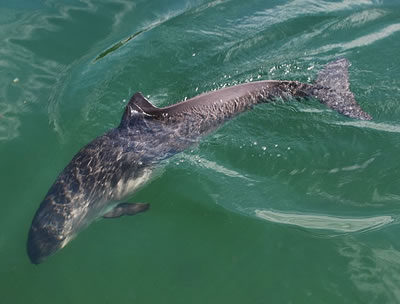Porpoises

Facts about creatures
- Home
- Animal Classification
- Animal Habitats
- Amphibians
- Arthropods
- Bats
- Birds
- Carnivorans
- Cetaceans
- Chordates
- Crustaceans
- Dinosaurs
- Diprotodonts
- Elephants
- Fish
- Golden Mole
- Insects
- Lagomorphs
- Mammals
- Mammal Teeth
- Marsupial Mole
- Metamorphosis
- Mollusks
- Primates
- Reptiles
- Rodents
- Ruminants
- Soricomorphans
- Tenrec
- Tetrapods
- Vertebrates
Porpoises
Porpoises are cetaceans that belong to the family Phocoenidae.
They usually live in waters off the coasts of oceans and in estuaries. Some porpoises live in freshwater.
Porpoises usually have black, grey or tan backs and lighter-colored bellies.
A porpoise’s diet may consist of fish, squid or other mollusks, and crustaceans.

Difference Between Porpoises and Dolphins
Porpoises resemble dolphins and are sometimes confused with dolphins.
However, porpoises tend to be shorter and chubbier than dolphins. A porpoise’s snout is shorter and blunter than a dolphin’s snout.
Dolphins and porpoises have differently-shaped teeth. While a dolphin’s teeth are cone-shaped, a porpoise’s teeth are flat and spade-shaped.
Porpoises have triangular dorsal fins (back fins) while dolphins have falcate (sickle-shaped) dorsal fins. (Some porpoises and some dolphins do not have dorsal fins.)
While dolphins make sounds that human beings can hear, the sounds that porpoises make are inaudible to humans.
In general, porpoises tend to be shyer around humans than dolphins.
Porpoise Species
There are 6 living species of porpoise:
- the harbor porpoise (Phocoena phocoena)
- the spectacled porpoise (Phocoena dioptrica)
- Burmeister’s porpoise (Phocoena spinipinnis)
- Dall’s porpoise (Phocoenoides dalli)
- the finless porpoise (Neophocaena phocaenoides)
- the vaquita (Phocoena sinus)
The vaquita is the smallest living cetacean on Earth. A vaquita can grow up to about 5 feet long and weigh up to about 110 pounds. Vaquitas live in the Gulf of California and are critically endangered.
“Vaquita” is Spanish for “little cow.”
Classification
The porpoise family, Phocoenidae is part of the superfamily Delphinoidea, which also includes oceanic dolphins, the beluga whale (Delphinapterus leucas) and the narwhal (Monodon monoceros).
Delphinoidea is part of the suborder Odontoceti, which also includes river dolphins and toothed whales.
Some people say that all odontocetes are toothed whales. Therefore, porpoises and dolphins are whales.
Generally, people use the words “whale” to describe the larger odontocetes and the words “porpoise” and “dolphin” to describe the smaller ones.
All odontocetes- toothed whales, dolphins and porpoises – share the following characteristics:
- They have teeth and are predators.
- They use echolocation for navigation and hunting.
- They live in groups and are cooperative hunters.
- An odontocete has one blowhole. (Baleen whales have two blowholes.)